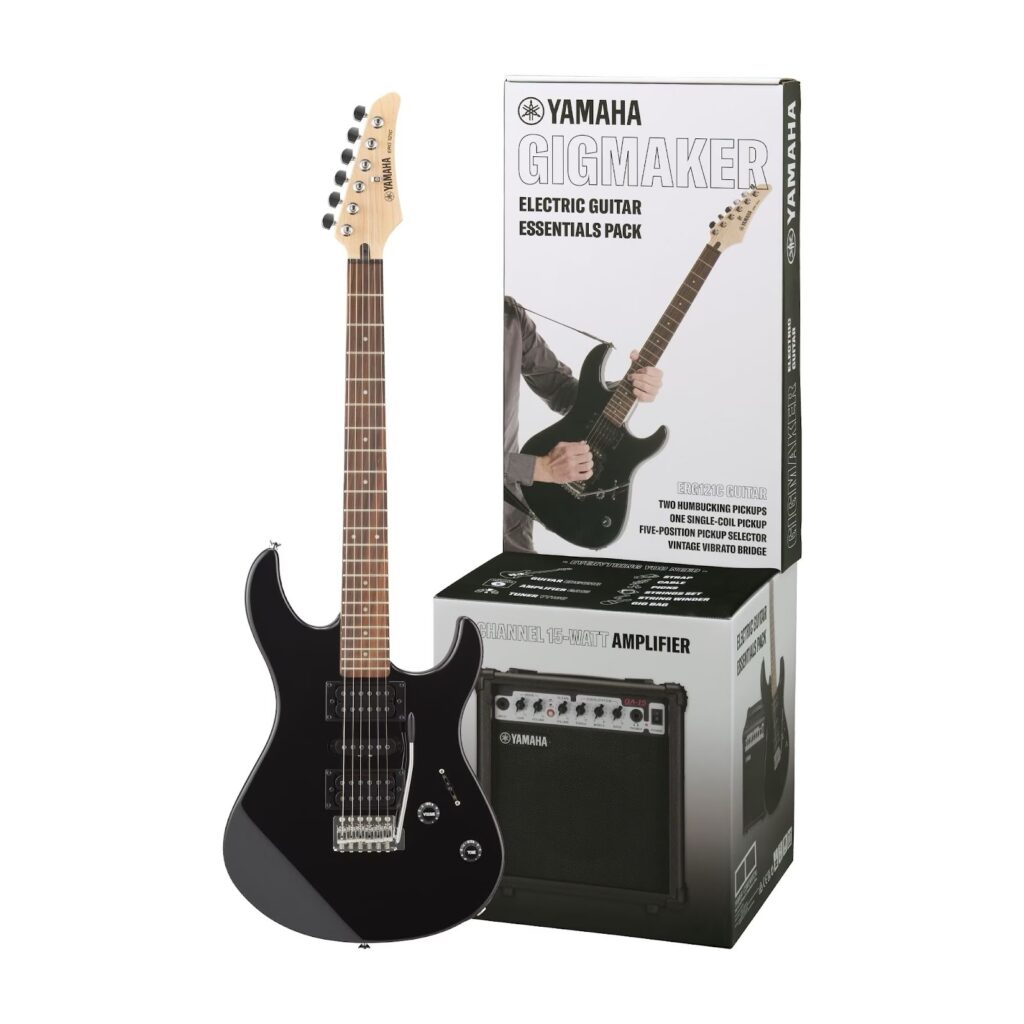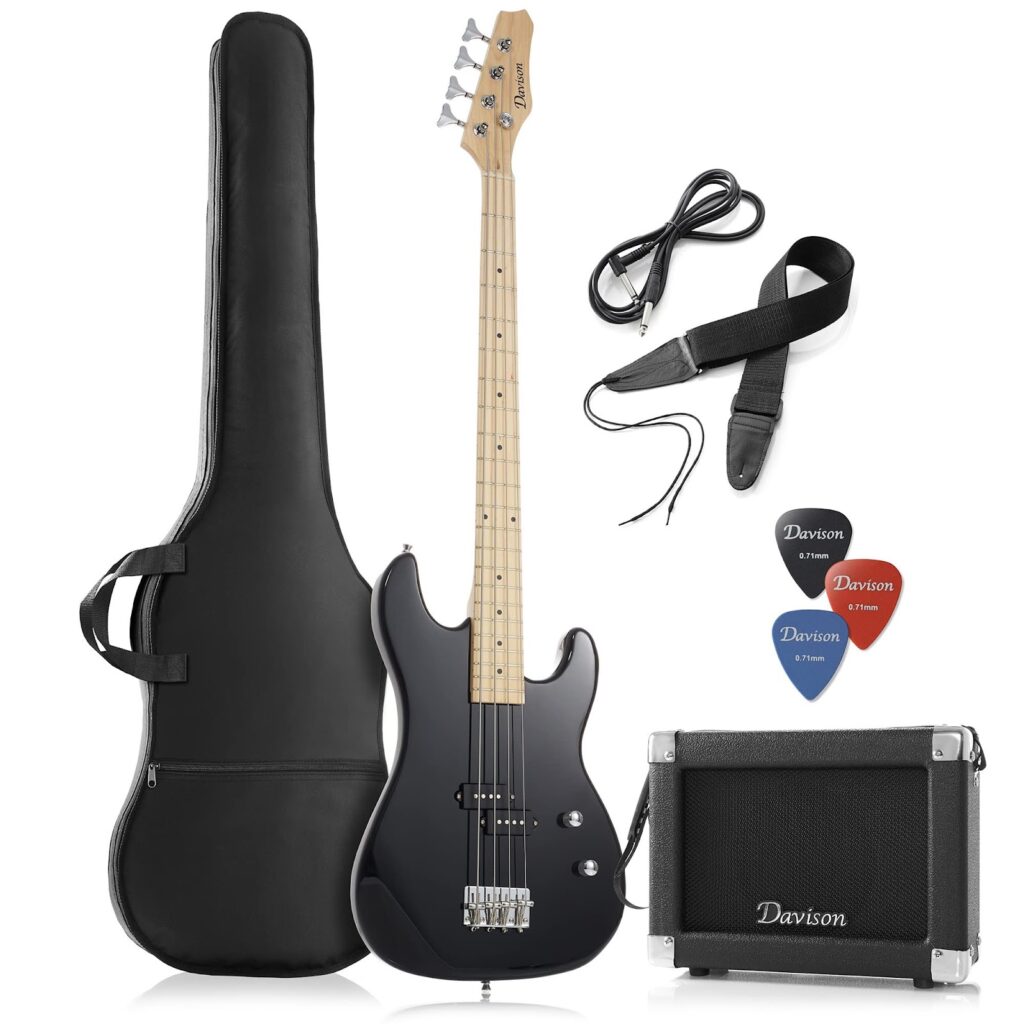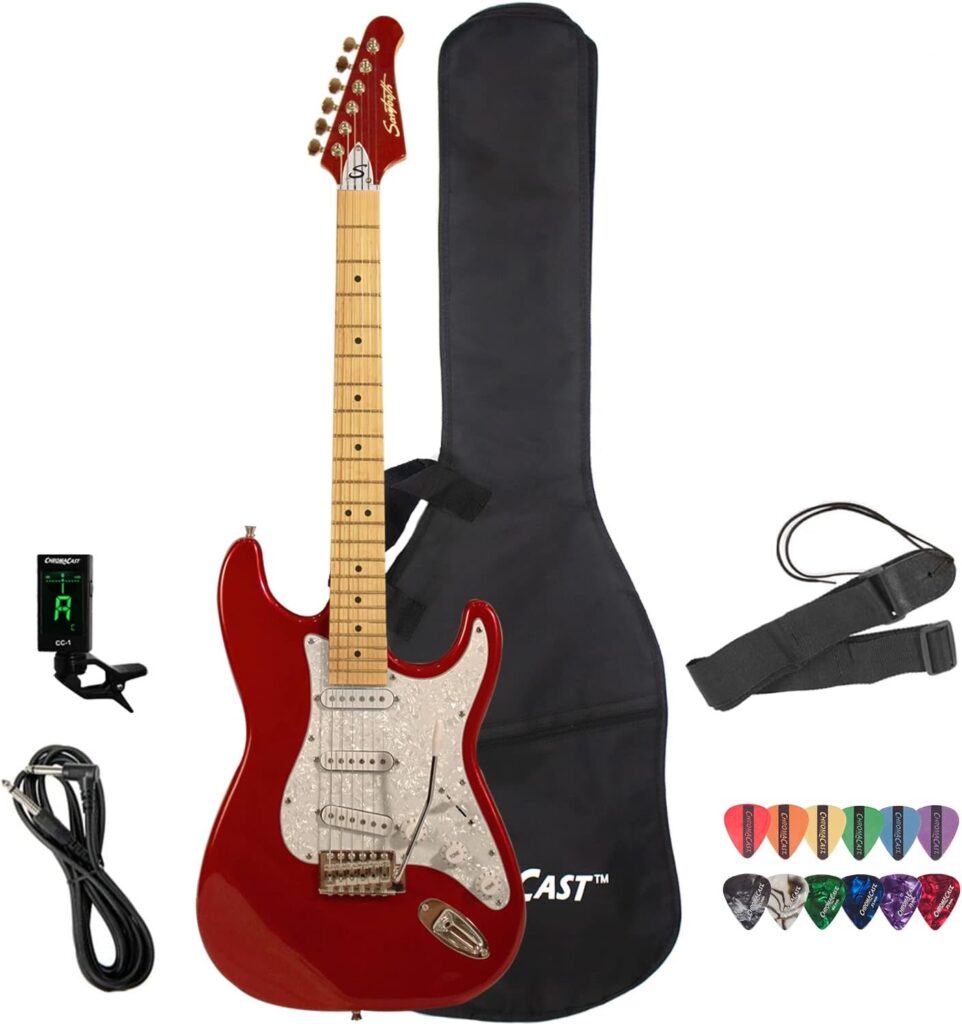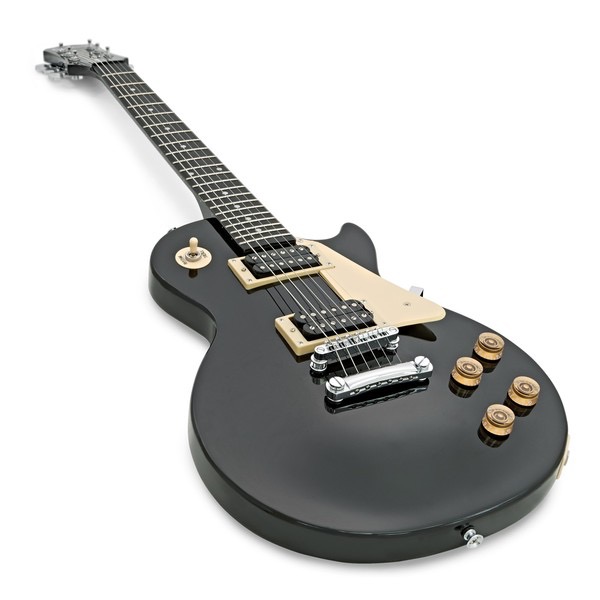Embarking on a musical odyssey, especially for neophytes eager to master the electric guitar, requires a discerning choice of instrument. This guide delves into an eclectic selection of electric guitars tailored for beginners, blending aesthetics with functionality to kindle your musical journey.
Guide to the Top 10 Electric Guitars for Beginners
1. The Comprehensive Black Electric Guitar Set

This ensemble, comprising a full-size black electric guitar, amplifier, case, and assorted accessories, is highly recommended by connoisseurs of electronic musical apparatus. A harmonious blend of affordability and user-friendliness, this model is renowned for its stability in tuning and lightweight design, facilitating effortless handling. The Humbucker pickup enhances the rock sound quality significantly. This electric guitar not only fits your budget but also serves as an excellent initiation into the world of guitar playing.
Advantages:
- Budget-friendly for beginners;
- Consistently maintains tuning;
- Lightweight and robust.
Disadvantages:
- Supplementary accessories may be superfluous.
2. Yamaha Gigmaker Electric Guitar

For those seeking top-tier electric guitar brands that offer exceptional value, the Yamaha Gigmaker emerges as a stellar choice. Its design exudes a premium vibe with a deep blue finish, and its construction emphasizes durability. The guitar’s impeccable craftsmanship ensures a smooth and comfortable play experience, making it an ideal choice for novice guitarists.
Advantages:
- Includes an instructive DVD for beginners;
- Premium appearance;
- Suitable size for teenagers and adults.
Disadvantages:
- Strings may require eventual replacement.
3. Full-Size Electric Bass Guitar Starter Pack

This package is an ideal selection for those at the commencement of their guitar journey. The full-size electric bass guitar, replete with essential features, is paired with cables, a strap, and an amplifier. Its lightweight design and ease of handling make it a commendable choice for beginners.
Advantages:
- Consistently accurate tuning;
- Excellent sound quality;
- Comfortable weight.
Disadvantages:
- Straps may be somewhat short.
4. Rise by Sawtooth ST-RISE-ST-LH-SB-KIT-1 Electric Guitar

The Rise model by Sawtooth is a splendid option for those seeking a musical gift. Its enchanting aesthetics, complemented by a durable maple neck and basswood body, make it a worthwhile investment. The kit includes all necessary accessories, offering a complete package for practice.
Advantages:
- Superior build quality;
- Attractive design;
- Budget-friendly.
Disadvantages:
- Pickup may need enhancement.
5. Epiphone Les Paul Electric Guitar Player Pack

Epiphone introduces a beginner-friendly model that strikes a balance between cost and features. This guitar is ideal for those embarking on their musical journey with a modest investment. It offers impressive tuning and sound, complemented by an array of accessories including a chromatic tuner and a strap.
Advantages:
- Ideal for beginners;
- Outstanding build quality;
- Aesthetic and comfortable to hold.
Disadvantages:
- The knob may be less functional.
6. Squier by Fender Affinity Telecaster

Perfect for both novices and professionals, this model boasts time-tested features and design innovations. Its adjustable bridge and tone control options allow for precise sound customization, making it a suitable choice for music enthusiasts.
Advantages:
- Attractive design;
- Efficient fingerboard layout;
- Reliable tuning.
Disadvantages:
- Susceptible to dirt and oil accumulation.
7. Sawtooth Candy Apple Red Electric Guitar

Renowned for its versatility and value, this guitar appeals to both beginners and seasoned players. Its sycamore body and tremolo bridge ensure robust tuning, while the comprehensive package includes all essential accessories for immediate playability.
Advantages:
- Reasonably priced;
- Durable construction;
- Accurate tuning.
Disadvantages:
- Some components may be of lesser quality.
8. Squier by Fender Bullet Strat

This model offers a comfortable grip and easy playability, making it suitable for beginners. Its large frets and diverse pickup options facilitate a variety of musical styles, while the adjustable truss rods are a notable feature.
Advantages:
- Glossy and protective finish;
- Durable and affordable;
- Beginner-friendly.
Disadvantages:
- Plastic pick guard.
9. Metallic Blue Junior Kids Mini 3/4 Electric Guitar

An excellent choice for children beginning their musical journey, this guitar includes a comprehensive instructional DVD. The combination of a maple neck and basswood body ensures durability, and the dual humbucker support adds to its appeal.
Advantages:
- Suitable for children;
- Budget-friendly;
- Durable construction.
Disadvantages:
- The amplifier may be basic.
10. Epiphone Les Paul-100 Electric Guitar

This model is an excellent choice for beginners seeking a comprehensive package. Its construction emphasizes strength and longevity, with a basswood body and Maplewood neck. The guitar offers versatile playability and an attractive design.
Advantages:
- Versatile musical range;
- Full and beautiful sound;
- Ideal for beginners.
Disadvantages:
- Packaging requires improvement.
Navigating the Selection of Ideal Beginner Electric Guitars
For newcomers, the outward appearance of each guitar may appear remarkably similar. Universally, guitars exude an inherent beauty, yet for both the neophyte and the virtuoso of music, the structure, dimensions, craftsmanship, and tactile sensation of each guitar resonate as a reflection of the type of music it possesses the potential to create. To discern the optimal electric guitar tailored for beginners, a meticulous evaluation of several factors becomes imperative.
The Classification
Broadly, electric guitars can be categorized into three fundamental genres. The Classical guitar, adorned with nylon strings, emerges as a superlative choice for novices. This instrument weaves intricate musical tapestries encompassing classical, Jazz, and Bossa Nova, among others. Conversely, the Acoustic variant, distinguished by its steel strings, is favored for genres such as Acoustic Rock, Jazz, Bluegrass, Blues, Country, and Folk. Renowned American musicians have extolled the virtues of the Acoustic guitar, with luminaries like Alvino Rey even employing this musical tool in front of vast audiences in expansive orchestral ensembles before pioneering the first pedal steel guitar for Gibson electric guitars. It stands as the preferred instrument for accomplished guitarists, capable of producing the mellifluous strains of Blues, Country, Heavy Metal, Jazz, and Rock. Should one aspire to emulate Bryan Adams, the bass guitar stands as the instrument of choice.
Sonic Excellence
Among the myriad considerations in the quest for the finest electric guitar for beginners, the auditory profile assumes paramount importance. The music it engenders must resonate with brilliance, fullness, and precision.
Instrumental Anatomy
For novices and maestros alike, the body composition of the guitar demands meticulous contemplation. Typically, the guitar’s body is constructed from various types of hardwood, including rosewood, ash, alder, maple, and mahogany, each endowed with a distinctive grain, hue, and density. Consequently, each imparts a unique aesthetic to the guitar while endowing it with a distinct tonal signature.
Guitar bodies typically assume four primary configurations:
- Solid Body Type: This represents the archetypal guitar body, prevalent in the majority of electric guitars. As the nomenclature suggests, the solid body is substantial, apart from the hollow spaces housing the guitar’s electronic components;
- Chambered Body Type: A chambered guitar body comprises multiple voids designed to reduce weight while enhancing durability and tonal quality;
- Semi-Hollow Body Type: This hybrid amalgamates elements of both hollow and solid body designs, featuring thickened edges while maintaining a solid core;
- Hollow Body Type: As the nomenclature implies, this type of guitar body is entirely hollow, amplifying the instrument’s resonant qualities and enriching its sonic character.
The Neck
The guitar neck, another pivotal facet, is likewise constructed from hardwood, commonly employing materials such as maple, rosewood, or basswood. The neck’s length dictates the spatial arrangement of the frets. The optimal electric guitar for beginners typically features a standard neck, while many artists favor a 24-fret neck for its expanded tonal range. The conventional electric guitar boasts a 25.5-inch scale, though several brands may opt for a 25-inch scale. The attachment method of the guitar neck to its body constitutes an additional aspect to ponder.
- Set-in Neck: In this configuration, the neck is detached from the body, with both components joined using a strong adhesive, creating the illusion of a seamless, single hardwood unit. The set-in neck imparts robustness and character to the guitar;
- Bolt-On Neck: This design exposes the neck attachment through visible bolts, affording greater adjustability for the player’s convenience;
- Neck-Through-Body: Semi-hollow and solid body guitars typically employ neck-through-body construction, where a single, unbroken hardwood piece spans from the uppermost section of the neck to the lowermost part of the body, endowing the instrument with maximum durability.
Stringing Matters
Considering the gamut of options spanning from 4 to 20 strings, transitioning from nylon to steel, the diversity is profound. While novices are recommended to commence with nylon strings, seasoned musicians often tailor their choice to align with their preferred musical genre. Electric guitar strings, akin to the neck, determine the instrument’s playability, with their proximity to the fingerboard affecting musical modulation. Guitarists conventionally utilize one hand for plucking or strumming the strings. In electric guitars, transducers known as pickups convert string vibrations into electronic signals, subsequently amplifying and channeling them through speakers, thereby generating the audible melodies we perceive.
Pick-Up Insights
Pickups serve as pivotal elements in achieving precise tonal characteristics. Typically, a guitar incorporates two pickup assemblies, although additional configurations exist. Single-coil pickups endow a guitar with exquisite tonal qualities, while “humbucker” pickups find favor among guitarists performing in concert settings.
Control Mechanisms
An indispensable feature to consider in a guitar is the control switch, which enables the manipulation of volume and tone settings for each pickup. The control switch facilitates the blending or separation of pickups within the best electric guitar for beginners.
Bridging the Gap
Bridges play a crucial role, permitting players to adjust string height and length. Three primary bridge styles—standard, string-through, and tailpiece-integrated bridges—each offer distinctive approaches to string modification.
The Venue of Performance
The choice between a standard electric guitar and an acoustic-electric guitar hinges upon the intended performance venue. Home or instructional settings favor the former, while public performances employing microphones necessitate the latter.
Budget Considerations
Acquiring a novice’s electric guitar need not demand an extravagant investment, with a ceiling of two hundred dollars sufficing for an entry-level, reputable instrument from esteemed manufacturers. These industry stalwarts boast a legacy of crafting highly regarded musical instruments, ensuring longevity and exceptional value for the investment. Should one seek a comprehensive package, including an amplifier, strap, cables, and supplementary materials, a slightly higher budget may be warranted. Guitar sets often represent a cost-effective option, bundling all essential accessories.
Investing Wisely
Investing in a high-quality electric guitar:
- Embodies a prudent financial commitment;
- Affords peace of mind, particularly with reputable brands like Fender or Gibson, renowned for utilizing premium hardwoods that enhance sound quality as the instrument matures;
- Promises straightforward maintenance and ready availability of replacement components.
Does Aesthetics Matter?
Novice electric guitarists should temper their fascination with aesthetics, for several reasons. Firstly, most electric guitars, especially at the beginner level, adhere to a classic, timeless design. Consequently, excessive contemplation of the guitar’s style or form proves superfluous. Secondly, the guitar’s aesthetics carry minimal significance compared to its construction quality, tonal characteristics, and ease of playability. Thus, it behooves novices to focus primarily on the guitar’s build, tonal attributes, and ergonomic comfort.
Additional Considerations
In line with aesthetics, novices are encouraged to exercise discretion in evaluating the features of their chosen guitar. As neophytes, a comfortable guitar featuring three single-coil pickups or a single humbucking pickup, along with basic volume and tone controls, suffices. The journey toward exploring additional guitar features such as tremolos is best reserved for later stages of proficiency.
Exploration and Selection
Aspiring guitarists embarking on the quest for their inaugural electric guitar should embark on a comprehensive exploration of available options. Consultation with knowledgeable sales personnel at reputable guitar stores can provide invaluable insights. Extensive hands-on evaluation of different guitars allows novices to discern their preferences. Multiple stores should be canvassed to gauge quality at different price points. For those with greater financial latitude, premium guitars offer enduring playability, accommodating players of all skill levels.
Favored Brands
Prominent recommendations encompass Squier, Epiphone, and Yamaha guitars. Instruments from these manufacturers deliver exceptional value for beginners, enabling them to traverse the realm of guitar playing without imposing exorbitant financial burdens. Squier, a subsidiary of Fender, renowned globally even among non-guitarists, excels in producing budget-friendly guitars with exceptional craftsmanship. Likewise, Epiphone, affiliated with Gibson, offers affordable options for enthusiastic novices. Yamaha, a renowned multinational conglomerate, known for crafting a diverse range of products, including motorcycles and yachts, extends its commitment to excellence to electric guitars, ensuring player satisfaction.
Significance of Opting for the Best Electric Guitar for Beginners
Three pivotal reasons underscore the importance of selecting the finest electric guitar for beginners:
- Aesthetic Appeal: Electric guitars boast an array of styles, making them visually appealing. Some iconic heavy metal and hard rock musicians are synonymous with specific guitar styles or brands. However, it is imperative not to prioritize aesthetics over sonic quality. Novices should acquaint themselves with the fundamentals on a beginner’s guitar before venturing into the realm of elaborate electric guitars;
- The Power of Pick-Ups and Progression: The most significant advantage conferred by the best electric guitar for beginners resides in its pickups. The majority of electric guitars incorporate at least two pickups, which translate string vibrations into magnetic fields via electromagnetism. These signals are subsequently amplified and transmitted through speakers, allowing for a diverse tonal palette. As one gains proficiency, the instrument undergoes a transformative journey, offering enhanced capabilities and opportunities to explore more intricate melodies;
- Therapeutic Harmony: Music possesses the capacity to promote overall well-being, alleviate stress and anxiety, support recovery, aid in learning and academic performance, enhance communication skills, alleviate pain, boost memory, regulate mood, and enhance cognitive abilities. This therapeutic potential extends to individuals with disabilities, school-aged children, and those grappling with physical or emotional ailments. Music therapy, in conjunction with electric guitar playing, fosters relaxation and cognitive stimulation. It is advisable to approach learning with patience and a love for the craft, ensuring a calm and enjoyable journey.
Essential Accessories
Equipping oneself with essential accessories elevates the performance of the best electric guitar for beginners. Several critical components warrant consideration:
- Guitar Case: A protective enclosure to safeguard and transport the guitar, with options like the AME-30 designed for Archtop guitars and the Calton Electric Guitar Cases accommodating various electric guitar types;
- Amplification: An electric guitar’s sound quality is contingent upon the amplifier. It is advisable to test amplifiers in-store, exploring their full tonal range by manipulating various settings, including distortion options. Amplifiers with built-in distortion capabilities prove particularly beneficial for novices lacking dedicated effects pedals;
- Effects Box: An effects box enhances musical creativity by enabling diverse tonal alterations. Essential effect tones include distortion, chorus, reverb, amp emulation, and modulation modules. These facilitate experimentation and the crafting of unique sounds;
- Cables: Often overlooked but crucial, high-quality cables ensure optimal signal transmission between the guitar and amplifier.
In Conclusion
Embarking on the journey of mastering the electric guitar necessitates thoughtful consideration of numerous factors. The selection of the finest instrument is underpinned by an array of variables, including tonal preferences, ergonomic considerations, and performance venues. Quality brands, such as Squier, Epiphone, and Yamaha, extend accessible entry points for novices. It is crucial to remember that the true essence of the electric guitar experience transcends aesthetics and lies in the harmony created between the player and the instrument. Patience, dedication, and the pursuit of musical mastery pave the way for a fulfilling journey into the realm of electric guitar artistry.